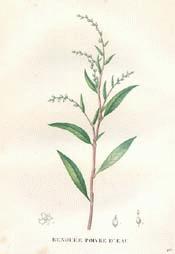
Botanical.com Home Page

|
Smartweed
(Polygonum hydropiper LINN.)
Click on graphic for larger image
|
Smartweed
Botanical: Polygonum hydropiper (LINN.)
Family: N.O. Polygonaceae
---Synonyms---Water Pepper. Biting Persicaria. Bity Tongue. Arcmart. Pepper Plant. Smartass. Ciderage. Red Knees. Culrage. Bloodwort. Arsesmart.
---Parts Used---Whole herb and leaves.
---Habitat---Great Britain and Ireland, rarer in Scotland; is a native of most parts of Europe, in Russian Asia to the Arctic regions. Found abundantly in places that are under water during the winter.
---Description---Annual. The branched stem, 2 to 3 feet in length, creeps at first, then becomes semi-erect. The leaves are lanceshaped, shortly stalked, wavy, more or less acute, glandular below, fringed with hairs. The stipules form a short inflated ochrea. The greenish-pink flowers are in long, slender, loose racemes, that mostly droop at their tips. There are six to eight stamens, two of which are functionless; two to three styles to the pistil. The fruit is black and dotted, as long as the perianth, three-sided and nut-like. The leaves have a pungent, acrid, bitter taste (something like peppermint), which resides in the glandulat dots on its surface, no odour.
[Top]
---Constituents---The plant's irritant medicinal properties are due to an active principle not fully understood, called Polygonic Acid (when discovered by Dr. C. J. Rademaker in 1871), which forms in green deliquescent crystals, having a bitter and acrid taste and strong acid reaction. It is destroyed by heating or drying. Other authorities later considered this body to be simply a mixture of impure tannic and gallic acids, together with chlorophyll, and failed to isolate a stable active principle. The plant contains 3 or 4 per cent of tannin. It imparts its properties to alcohol or water. The tincture must be made from the fresh plant; heat and age destroy its qualities.
It is said that this herb, together with Arbor Vitze, constituted the anti-venereo remedy of Count Mattei.
Linnaeus observes that the Water Pepperwort will dye woollen cloths of a yellow colour, if the material be first dipped in a solution of alum, and that all domestic quadrupeds reject it.
[Top]
---Medicinal Action and Uses---Stimulant, diuretic, diaphoretic, emmenagogue, efficacious in amenorrhoea. A cold water infusion is useful in gravel, colds and coughs.
In combination with tonics and gum myrrh, it is said to have cured epilepsy - probably dependent on some uterine derangement. The infusion in cold water, which may be readily prepared from the fluid extract, has been found serviceable in gravel, dysentery, gout, sore mouths, colds and coughs, and mixed with wheat bran, in bowel complaints. Antiseptic and desiccant virtues are also claimed for it. The fresh leaves, bruised with those of the Mayweed (Anthemis Cotula), and moistened with a few drops of oil of turpentine, make a speedy vesicant.
Simmered in water and vinegar, it has proved useful in gangrenous, or mortified conditions. The extract, in the form of infusion or fomentation, has been beneficially applied in chronic ulcers and haemorrhoidal tumours, also as a wash in chronic erysipetalous inflammations, and as a fomentation in flatulent colic.
A hot decoction made from the whole plant has been used in America as a remedy for cholera, a sheet being soaked in it and wrapped round the patient immediately the symptoms start.
In Mexico, the infusion is used not only as a diuretic, but also put into the bath of sufferers from rheumatism.
A fomentation of the leaves is beneficial for chronic ulcers and haemorrhoids - in tympanitis and flatulent colic, and as a wash in chronic inflammatory erysipelas.
It was once held that a few drops of the juice put into the ear would destroy the worms that it was believed caused earache.
There is a tradition, quoted in old Herbals, that if a handful of the plant be placed under the saddle, a horse is enabled to travel for some time without becoming hungry or thirsty, the Scythians having used this herb (under the name of Hippice) for that purpose.
It was an old country remedy for curing proud flesh in the sores of animals. Culpepper tells us also that 'if the Arsemart be strewed in a chamber, it will soon kill all the fleas.'
The root was chewed for toothache - probably as a counter-irritant - and the bruised leaves used as a poultice to whitlows.
A water distilled from the plant, taken in the quantity of a pint or more in a day, has been found serviceable in gravel and stone.
The expressed juice of the freshly gathered plant has been found very useful in jaundice and the beginning of dropsies, the dose being from 1 to 3 tablespoonfuls.
- In Salmon's Herbal, it is stated:
- 'It is known by manifold and large experience to be a peculiar plant against gravel and stone. The Essenee causes a good digestion, it is admirable against all cold and moist diseases of the brain and nerves, etc., such as falling sickness, vertigo, lethargy, apoplexy, palsy, megrim, etc., and made into a syrup with honey it is a good pectoral. The oil dissolves and discusses all cold swellings, scrofulous and scirrhous tumours, quinsies, congealed blood, pleurisies, etc.'
Waller recommends it also for 'hypochondriacal diseases.'
---Preparations and Dosage---Infusion, 1 OZ. to 1 pint - 1 tablespoonful three times daily. Fluid extract, 1 to 2 drachms. Tincture, 2 to 4 drachms.
---Other Species---From the AMERICAN SMARTWEED (Polygonum, Linn.), which possesses properties similar to those of the English species; a homoeopathic tincture is prepared from the fresh plant, which has been used with great advantage in diarrhoea and dysentery, in doses of 20 to 60 minims.
Common Name Index
A MODERN HERBAL Home Page
Bear in mind "A Modern Herbal" was written with the conventional wisdom of the early 1900's. This should be taken into account as some of the information may now be considered inaccurate, or not in accordance with modern medicine.
© Copyright Protected 1995-2025 Botanical.com
|

